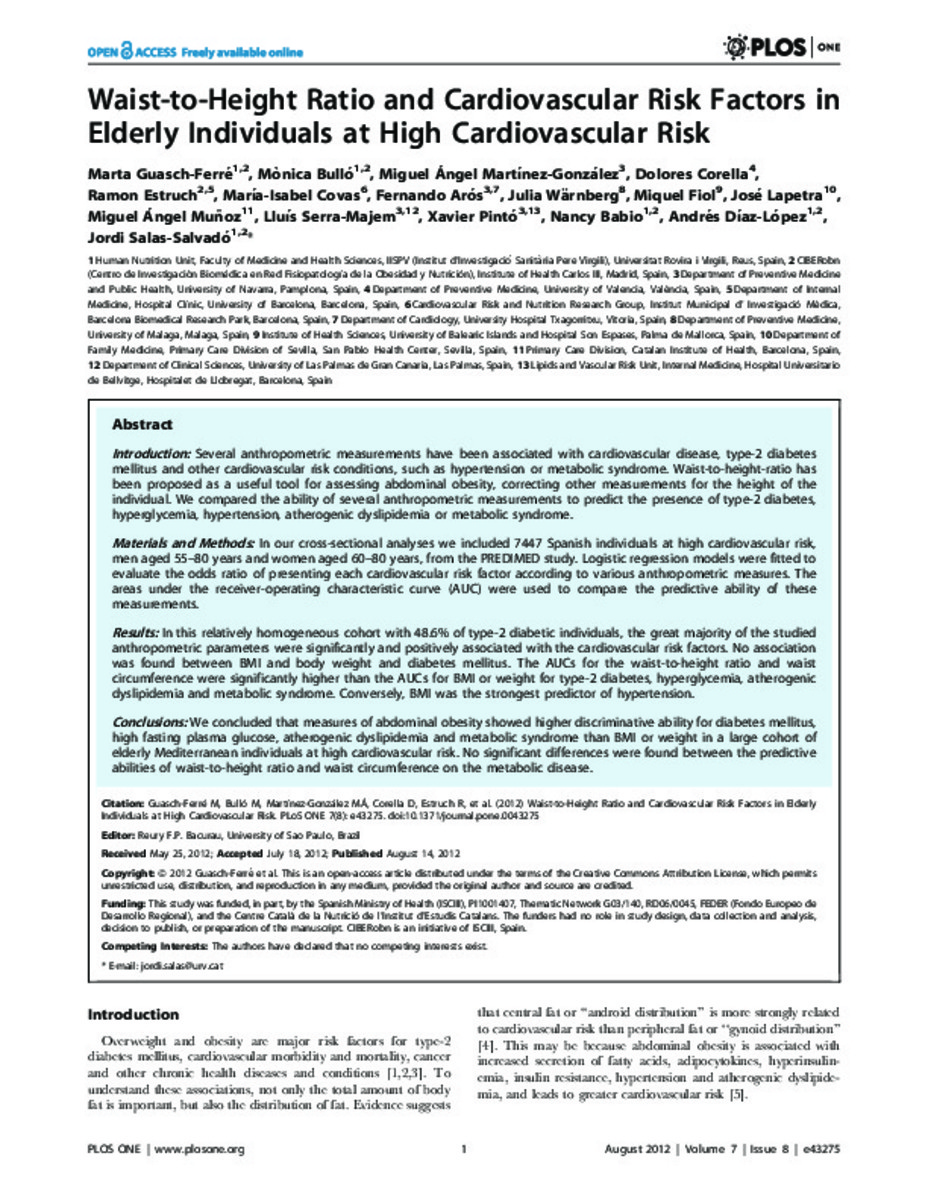Full metadata record
| DC Field | Value | Language |
|---|---|---|
| dc.creator | Guasch-Ferre, M. (Marta) | - |
| dc.creator | Bullo, M. (Monica) | - |
| dc.creator | Martinez-Gonzalez, M.A. (Miguel Ángel) | - |
| dc.creator | Corella, D. (Dolores) | - |
| dc.creator | Estruch, R. (Ramón) | - |
| dc.creator | Covas, M.I. (María Isabel) | - |
| dc.creator | Aros, F. (Fernando) | - |
| dc.creator | Wärnberg, J. (Julia) | - |
| dc.creator | Fiol, M. (Miquel) | - |
| dc.creator | Lapetra, J. (José) | - |
| dc.creator | Muñoz, M.A. (Miguel Angel) | - |
| dc.creator | Serra-Majem, L. (Luis) | - |
| dc.creator | Pinto, X. (Xavier) | - |
| dc.creator | Babio, N. (Nancy) | - |
| dc.creator | Diaz-Lopez, A. (Andres) | - |
| dc.creator | Salas-Salvado, J. (Jordi) | - |
| dc.date.accessioned | 2014-11-17T11:55:09Z | - |
| dc.date.available | 2014-11-17T11:55:09Z | - |
| dc.date.issued | 2012 | - |
| dc.identifier.citation | Guasch-Ferré M, Bulló M, Martínez-González M.A, Corella D, Estruch R, Covas M.I, et al. Waist to height ratio and cardiovascular risk factors in elderly individuals at high cardiovascular risk. PLoS One. 2012;7(8):e43275. | es_ES |
| dc.identifier.issn | 1932-6203 | - |
| dc.identifier.uri | https://hdl.handle.net/10171/37053 | - |
| dc.description.abstract | Introduction: Several anthropometric measurements have been associated with cardiovascular disease, type-2 diabetes mellitus and other cardiovascular risk conditions, such as hypertension or metabolic syndrome. Waist-to-height-ratio has been proposed as a useful tool for assessing abdominal obesity, correcting other measurements for the height of the individual. We compared the ability of several anthropometric measurements to predict the presence of type-2 diabetes, hyperglycemia, hypertension, atherogenic dyslipidemia or metabolic syndrome. Materials and Methods: In our cross-sectional analyses we included 7447 Spanish individuals at high cardiovascular risk, men aged 55–80 years and women aged 60–80 years, from the PREDIMED study. Logistic regression models were fitted to evaluate the odds ratio of presenting each cardiovascular risk factor according to various anthropometric measures. The areas under the receiver-operating characteristic curve (AUC) were used to compare the predictive ability of these measurements. Results: In this relatively homogeneous cohort with 48.6% of type-2 diabetic individuals, the great majority of the studied anthropometric parameters were significantly and positively associated with the cardiovascular risk factors. No association was found between BMI and body weight and diabetes mellitus. The AUCs for the waist-to-height ratio and waist circumference were significantly higher than the AUCs for BMI or weight for type-2 diabetes, hyperglycemia, atherogenic dyslipidemia and metabolic syndrome. Conversely, BMI was the strongest predictor of hypertension. Conclusions: We concluded that measures of abdominal obesity showed higher discriminative ability for diabetes mellitus, high fasting plasma glucose, atherogenic dyslipidemia and metabolic syndrome than BMI or weight in a large cohort of elderly Mediterranean individuals at high cardiovascular risk. No significant differences were found between the predictive abilities of waist-to-height ratio and waist circumference on the metabolic disease. | es_ES |
| dc.language.iso | eng | es_ES |
| dc.publisher | Public Library of Science | es_ES |
| dc.rights | info:eu-repo/semantics/openAccess | es_ES |
| dc.subject | Metabolic syndrome | es_ES |
| dc.subject | Anthropometric indicators | es_ES |
| dc.subject | Abdominal obesity | es_ES |
| dc.subject | Screening tool | es_ES |
| dc.subject | Disease risk | es_ES |
| dc.subject | Metaanalysis | es_ES |
| dc.subject | Men | es_ES |
| dc.subject | Classification | es_ES |
| dc.subject | Questionnaire | es_ES |
| dc.subject | Association | es_ES |
| dc.title | Waist to height ratio and cardiovascular risk factors in elderly individuals at high cardiovascular risk | es_ES |
| dc.type | info:eu-repo/semantics/article | es_ES |
| dc.identifier.doi | http://dx.doi.org/10.1371/journal.pone.0043275 | es_ES |
Files in This Item:
Statistics and impact
Items in Dadun are protected by copyright, with all rights reserved, unless otherwise indicated.






